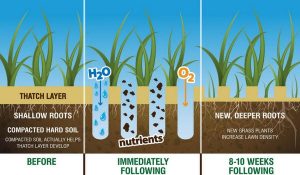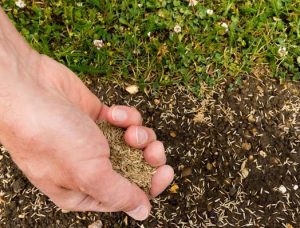3 Steps To Wake Your Lawn Up For Spring
March 31st 2022

Winter is tough on grass and snow is not only what causes the damage. Your lawn will suffer from elements causing ice damage, snow mold and even the low temperatures can kill some of the grass. The cold season also brings snow which piles up after each snow fall the weight can put stress on your lawn and compact the soil. After a season of cold weather and snow your lawn will need a kick start in order to wake it up. There are 3 steps that are important to do every spring to give your lawn its best chance to come back and reverse the winter damage. These steps are:
- Aerate
- Power Rake
- Over Seed
Step 1: Aerate
Aerating is the first step to waking up your lawn and is arguably the most important. This process is what allows air, water and nutrients to penetrate to the deepest part of the lawn. In order to have a healthy lawn after its taken a beating from jack frost, is to ensure you feed the roots as deep as possible, and to decompress the soil. Without the required elements the lawn will have shallow roots and the lawn can become patchy, be infiltrated with weeds or even die.

In the image above it shows how the aerate process works, so you can clearly see what a difference it makes having those deep air pockets. As mentioned above aerating also decompresses the soil, again aiding in getting those nutrients through out the soil to all the roots. With people walking on the lawn over the winter, as well as the weight of ice/snow the soil gets really compacted. This leaves less space for air and water to move freely thus feeding thus the roots will become shorter as they are starving for nutrients. You want to make sure you are aerating every year, usually in March to start your lawn breathing and decompressing so that you can get max benefit from watering and fertilizing later on down the road.
Step 2: Power Rake
Many people will aerate and power rake or de-thatch at the same time to maximize the benefits of each service. Both work hand in hand to help promote deep root growth and decompress the soil. Every year your lawn accumulates a layer of grass stems, stolons and rhizomes(both living and dead). This layer sits on the top soil, and is called "thatching".

You always want to have a layer of thatching to control the temperature of the soil and allow it to retain moisture, similar to what mulch does for your garden. After the fall and winter that layer has built up and will continue to get thicker as the year progresses. The ideal thatching thickness is 1/2 inch, once you start getting a thickness of more than 1 inch you can start running into problems with your lawn. Some problems may include:
- Air, water and nutrients not able to get to the roots
- Insect infestations
- Lawn diseases
- Spongy lawn
To keep this layer to around 1/2 inch you will need to power rake your lawn after you aerate to get rid of the thick layer of thatching. This will keep the barrier between the thatching and top soil thin enough to allow air, water and nutrients to penetrate to the deeper roots for a stronger, healthier lawn. For power raking you do not want to use a regular leaf rake, as you want the rake to have strong, short prongs to pull up the thatch. Your going to want to go slower with this to ensure you are grabbing the debris and not skipping over it. Once you are done power raking you will want to grab your leaf rake and gather up all the thatching. Power raking combined with the aerating will give your lawn a great foundation for a healthy lawn, as we all know everything needs to start with a solid foundation, which will help with your 3rd step over seeding.
Step 3: Over Seeding
Your lawn has more than likely suffered from ice damage during the winter and thus some of the grass may have died. Once grass is dead you cannot bring it back to life, only grass that has gone dormant can be revived. This will leave you with a patchy lawn and prone to insects and weeds. You have already aerated and power raked the lawn to open up your lawn and get it ready to receive nutrients. So now is the perfect time to over seed your lawn, which is sounds exactly like it sounds, you simply spread new grass seed over the entire lawn. New grass seed needs frequent watering which makes spring the optimal time to do this, spring tends to bring more rain. Some lawn care specialist have found that the lawn that is surrounding older homes have a variety of grasses that are not suitable for the current climate and are not durable enough for constant use. Since the lawn is strained it is prone to disease and insects which will cause the lawn to turn brown and die. Over seeding with a quality grass seed that is meant for area will ensure you have a thick and healthy lawn.

There are many benefits to over seeding such as:
- Reduces erosion
- Creates a think lawn that can retain nutrients
- Creates great curb appeal thus increasing your homes market value
- Prevents pests and disease
Choosing the right grass seed is very important, as some lawns get more sun than others and the season start and stop at different times. The Scotts brand has so many great choices and can be picked up at any local home improvement store. I have listed a couple of grass seed suggestions that are available at Canadian Tire:
- For lawn that gets more shade: Scotts Turf Builder Quick + Thick Shady Mix
- For lawns that get mixed sun and shade: Scotts Turf Builder Quick + Thick Sun and Shade Mix
- For full sun lawns: Scotts Turf Builder Quick + Thick Sunny Mix
**Make sure that you water the lawn often when seeding. After doing these 3 steps you are off and running to a beautiful green lawn.


